You already know that King Arthur Flour and I have a long standing love affair. KA Flour is the flour I use in my kitchen for almost all of my baking.
Right now I have fourteen whole and partial bags of different KA flour in my fridge, my flour containers, and my freezer: AP, Whole Wheat, White Wheat, Pumpernickel, Semolina, Buckwheat, Extra Fancy Durum, French Style, Bread, European Artisan Bread,
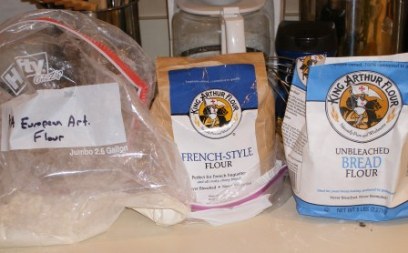
Sir Lancelot High Gluten, Pastry, Queen Guinevere cake,
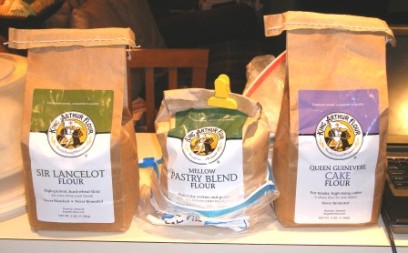
and this little bag of Sir Galahad Artisan.
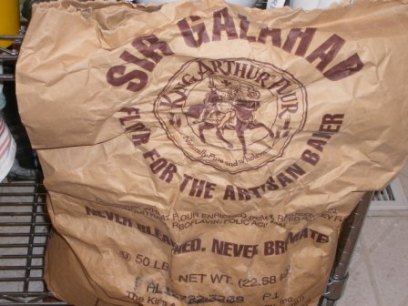
Yup, you can say I'm pretty much married to the King's flour.
So, when our host kitchen, Sara of I Like to Cook announced the bread for this month was King Arthur Flour's Pane Francese,
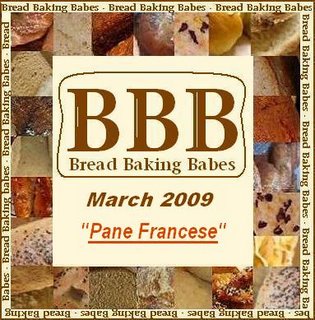
to say I did a little dance of joy around my kitchen would be a mild statement. I'm pretty sure PJ, Halley, Susan and the rest of the gang up there near the White River felt the ground shaking.
One the things I love the most about baking with The Babes, besides all the laughing, drinking, and support we give each other, is there isn't one of us who isn't afraid to challenge the rest of us with a new technique. The technique we are tackling this month is using a chef to make a levain.
A chef, in the venacular of bread making, is a little bit of left over dough from a previous bread or a liquid starter made by fermenting flour, water and sometimes fruit, that you use as the leavening agent. In my case, my chef is a bit of dough I made from my mother starter, Moe.
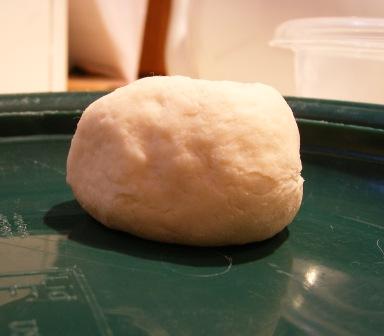
Using leftover dough from the previous day's baking is a common way that the mild sourdoughs of Europe are made.
To make the levain, you tear up the chef

and using warm water or milk, you dissolve the chef

add flour and make another stiff dough (like we do in the Pane Francese) or a sponge. After it rises until double, about five to six hours, you have what is called a "first stage levain".

You repeat this to achieve a second stage levain by using all the first stage levain and more flour and water.
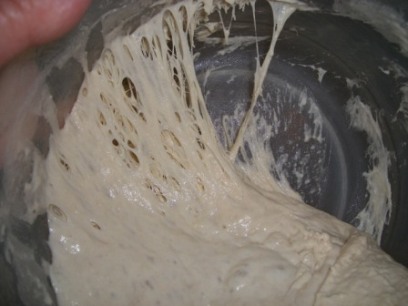
(Look at the gluten strands in my second stage!)
You save a bit of this second stage to act as a chef for future breads. After you've wrapped up your new chef, you are ready to make the dough and set it aside for a nice long rise.
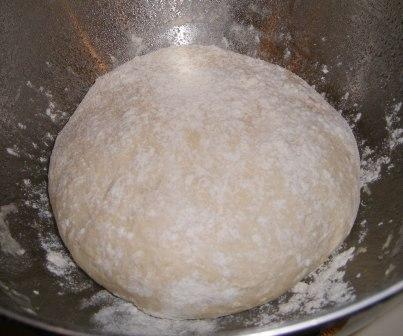
Normally, this stage is six to eight hours so, when I use a chef/levain method of making bread, I try to time it so that the dough can rise overnight and I can form the loaves in the morning. This means the loaves have the whole day to rise and I have fresh baked sourdough bread for dinner.
But, this time, my dough got a really, really nice long extended rise; like a three day rise! There's a pretty funny story here that will illustrate what a forgiving dough this is and why a long slow rise works so well for this style of bread making.
You see, I made the dough last Saturday and, as usual, put it in my oven (off) to spend the night in a nice warm draft free place. The next morning, I got up checked on it, and set it aside because I had a birthday cake to bake for our receptionist at work. After the oven had cooled off from the cake baking, I put the dough back in the oven to clean up the kitchen, intending to form the loaves and bake them before going to bed so I could bring one into work the next day.
But, before I got to work on the next stage of the Pane Francese, I started to feel kind of feverish and achy. By the time I was done cleaning up the kitchen my ears were ringing and I was feeling down right awful. So off to bed I went, where I stayed for the rest of the day and all day Monday, my poor Pane Francese dough just sitting in its oven home.
After spending all day Sunday and Monday in bed, I was feeling almost human (and I have that project from hell still going on) so I went back to work on Tuesday. At about 1pm I had a moment of "clarity". I remembered that my dough for the Pane Francese was still in my oven!
Luckily, I live less than one mile from work so I rushed home, expecting to have the dough blob that ate East Norwalk living in, around and under my oven. But I was pleasantly surprised to find that while the dough had dislodged the top of container and was starting to make a march for the oven door, it had stayed pretty well contained and was covered with the most lovely large bubbles of gas.
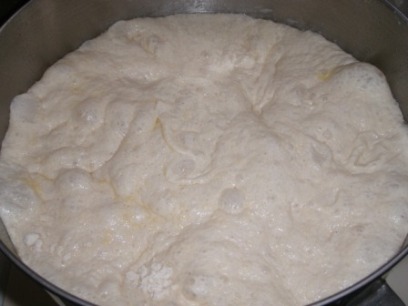
I floured my counter, poured the dough out,
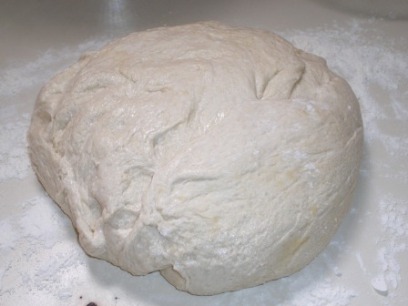
and, since it had been sitting and rising for so long, decided that support for the dough during the last rise was called for as the gluten in dough was probably relaxed beyond being able to support the weight of the dough during this shaping rise.
Besides this gave the opportunity to use two things I don't use all that much when I make bread, my batard pan
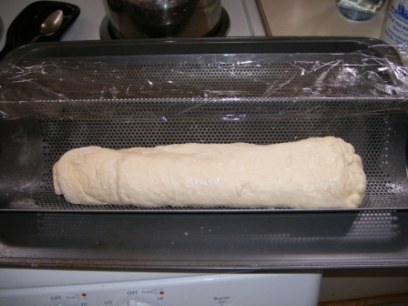
and my brotform.
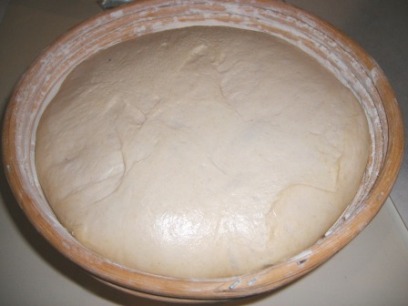
When I got home from work at 8pm that night I had two really nice risen loaves of bread all ready to bake.
Tossing my unglazed quarry tiles, you know that ones that caused me to get banned from the Watertown, MA Home Depot for taking pictures of, into the oven I set about preheating the oven. Sidebar here: When I'm going to be using the quarry tiles, I tend to preheat my oven at 500 degree for 30 minutes and then turn the oven down to the required temperature which in this case is 450 degrees. I use this pre-heating time to also give these types of breads a boost in the last few minutes of their rise by placing them on top of my stove and using the heat radiating from the oven.
Because my oven is so small I had to bake in two stages, batard first
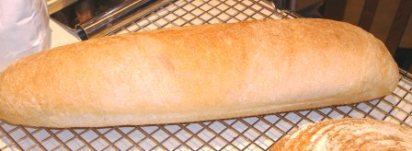
and then boule.
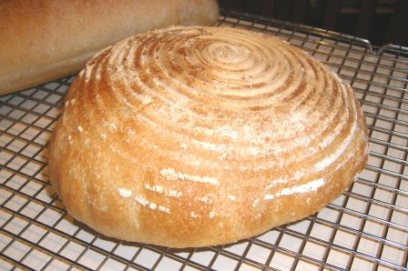
Not surprisingly, my boule deflated when I unmolded it from the brotform but this dough had great oven spring and it puffed right back up. Thirty five minutes later I had nice golden brown bread with crisp tops.
Slicing into them after they had cooled completely revealed an airy crumb in the batard
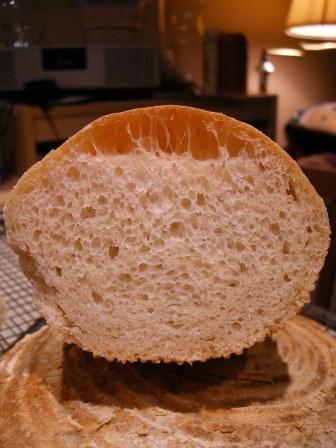
and these wonderfully craggy perfect holes in the boule.

The taste was nice and mild, exactly like the bread I eat when I'm in France and Belgium.
Thanks Sara for chosing such a great bread that tested our bread making techniques this month. Thanks King Arthur Flour for having such a fantastic product in your flour and for having that bread/baking/flour porn site you call The Baker's Banter. I find inspiration not to mention my daily caloric intake of sugar there almost daily.
To see how the rest of my fellow Babes fared this month with the King Arthur Flour Pane Francese, go check out their blogs by following the links on my sidebar. If you want to be a Bread Baking Buddy with the Babes this month, go check out Sara's post for all the details. Since she is Host Kitchen, she's in charge of when you will need to have your bread baked.
Pane Francese
From The King Arthur Flour Company
Yeild: two loaves
Note: You will need almost two full days to make this bread.
Creating the First-Stage Levain
chef (1/4 cup leftover dough, or 1/4 cup sourdough starter, unfed)
1/4 cup warm (75 - 80 degrees), chlorine-free water
1/2 cup King Arthur Unbleached Special Bread Flour
Let the chef soften in the warm water, then whisk out any lumps. Mix in the flour until yo8u've formed a stiff dough. Turn the dough out onto a floured surface, and knead it for 5 to 8 minutes. The chef (now called a levain) should be moist but firm. Place the levain in a bowl, cover it with a damp cloth, and let it rise in a warm place till doubled. This will take 5 to 6 hours.
Second-Stage Levain
All of the First-Stage levain (from above)
1/2 cup warm, chlorine-free water
1 1/2 cups King Arthur Unbleached Special Bread Flour
"Refresh" the levain by placing it in a medium-sized bowl, chopping it into small pieces, and adding the water and 1/2 cup of the flour, stirring till smooth. Add the remaining flour gradually to create a stiff dough. Knead the dough for several minutes, then return it to the bowl, cover it with a damp cloth, and let it rise for 3 to 5 hours, till it doubles in size. Punch down the risen levain, and reserve 1/4 cup as your next chef. (Let the piece ferment at room temperature for 3 hours, then wrap it in plastic and store it in the fridge. It'll develop a hard crust; that's OK.)
Dough
all of the second-stage levain (from above)
3/4 cup warm, chlorine-free water
2 teaspoons salt
2 cups King Arthur Unbleached Special Bread Flour
Chop the levain into small pieces, and mix them with the water, stirring till they begin to dissolve. Add the salt, then 1 1/2 cups of the flour. Turn the dough onto a lightly floured or lightly greased work surface, and knead until the dough is smooth and satiny, adding only enough additional flour to keep the dough from sticking unbearably.
(Note from Breadchick, I used a combination of three King Arthur flours for my dough, 1 cup Bread flour, 1/2 cup European Artisan Bread flour, and almost 3/4 cup of French style flour. It was rather humid in my kitchen on the day I made the dough so I needed a bit more flour to get the dough to come to the right consistency)
Return the dough to the bowl, cover it with a damp cloth, and let it rise in a warm place for 8 to 10 hours.
Shaping:
Cut the dough into 2 pieces, and shape each piece into a round or oval. Transfer the loaves to a lightly greased or parchment-lined baking sheet, or to a floured banneton; cover with a heavily floured cloth, and allow them to rise for 2 to 3 hours, or until they're almost doubled in bulk.
Don't slash or glaze the loaves.
Baking:
Bake the bread in a preheated 450°F oven for 35 to 40 minutes, or until they're a deep, golden brown. Allow to cool completely before slicing







